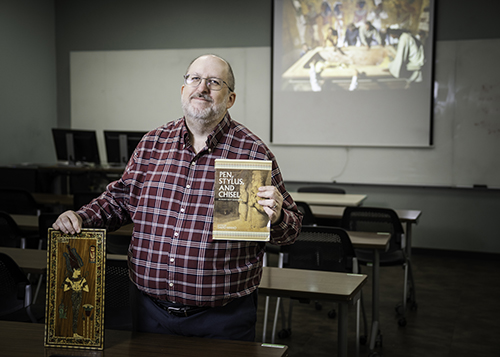
DENTON (UNT), Texas — It’s been 100 years since the sarcophagus of Pharaoh Tutankhamun, or King Tut, was unearthed near Luxor, Egypt. But Walt Roberts, a principal lecturer in the University of North Texas Department of History, sees ongoing potential for discovering more about the ruler’s short, mysterious life.
“The sarcophagus was the beginning of what we now call ‘Tutmania,’” said Roberts, who teaches a course on Ancient Egypt. “Before this time, nobody had even dreamed that Egypt had such a wealthy and noteworthy history — particularly concerning the burial practices of their pharaohs.”
In 1922, British archaeologist Howard Carter and his team discovered King Tut’s tomb, but bureaucratic hurdles delayed the opening of the sarcophagus until Jan. 3, 1924. The contents inside transformed the world’s perception of Ancient Egyptian culture and burial practices. Unlike many previously discovered pharaoh’s tombs, Tut’s had eluded thieves and remained untouched.
“King Tut’s tomb was situated behind a couple of later pharaohs in the Valley of the Kings. It was relatively hidden, providing protection from tomb raiders,” Roberts said. “When Carter and his company discovered Tut’s tomb, it was so well-concealed that it had been completely undisturbed.”
King Tut, a minor pharaoh during Ancient Egypt’s Amarna Period, gained historical significance through his father Akhenaten, who introduced monotheism to Egyptian society. Akhenaten declared Aten, the sun god, as the sole deity, with himself as the head priest. Despite the unpopular decision, it became Akhenaten’s legacy.
Tut was only eight or nine years old when he ascended to the Egyptian throne. He ruled with regents until he turned 16 and died in 1323 B.C., around the age of 18 or 19. Successors attempted to erase the Amarna Period’s history, but King Tut’s mummy and sarcophagus unveiled the past. Scholars suggest his mummification aimed to deify him.
“The traditional interpretation before Tut’s discovery had been that mummifying the body was a way to prepare it for the afterlife. There was a sense that the body would continue on after death,” Roberts said. “But new scholarly perspective after the discovery challenged this, suggesting that the burial of Tut was an exception to standard practice. The goal was not just an afterlife transition but an attempt to transform pharaohs into the actual deities they proclaimed to be in life.”
Today’s archaeologists and historians — aided by modern technologies such as DNA analysis and advanced imaging techniques — not only continue to deepen their understanding of King Tut, but also unravel more about Ancient Egypt in general, revealing more hidden tombs and artifacts.
Roberts said he continues to update the curriculum for his Ancient Egyptian history course as more information becomes available. The faculty fellow in UNT’s Military History Center and Jewish Studies Program believes the ever-evolving history is a key factor in the lasting interest in Ancient Egypt.
“Egypt is among the ancient civilizations that left behind abundant written and material evidence, including artifacts that have endured for thousands of years,” Roberts said. “There’s this fascination — people are intrigued with understanding their achievements, the reasons for their decline, and, most importantly, who gets to claim that legacy.”
UNT News Service Phone Number: (940) 565-2108